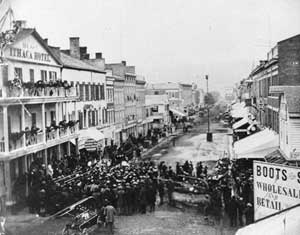
The Ithaca Hotel early 1800s
courtesy of The History Center
Histories of Cornell University include Carl Becker, Cornell University: Founders and the Founding (Ithaca, 1941), Morris Bishop, A History of Cornell (Ithaca, 1962) and Carol Kammen, Cornell: Glorious to View (Ithaca, 2003).
Major archival repositories include the Tompkins County Archive, Cornell University Archives, and the DeWitt Historical Society of Tompkins County.
Carol Kammen
Tompkins County Historian
2008
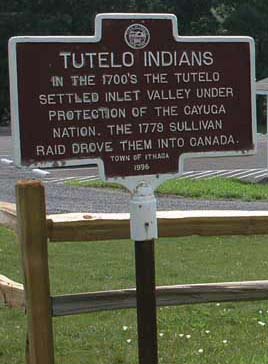
Before European settlement, this was home to the Cayuga Indians, one of the five –and then six–tribes that made up the Iroquois Confederation. They used the land lightly, placing semi-permanent settlements near the sources of fresh water, cultivating patches for produce and orchards. In the eighteenth-century, the Cayugas allowed the Sapony and Tutelo tribes migrating north from the Carolinas to settle on portions of land along the Cayuga Inlet where they built a village called Coreorgonel. In 1779, in the dire days of the American Revolutionary War when the outcome was less than certain, George Washington sent Major General John Sullivan into Iroquoia to drive the Indians west in an attempt to push them out of the conflict raging between the colonies and England. Sullivan directed Colonel Henry Dearborn to march down the west side of the lake, and Lieutenant Colonel William Butler, to go along the east side of Cayuga Lake, to destroy Cayuga villages and crops. Butler’s forces burned Coreorgonel, now the site of the Tutelo Park in the Town of Ithaca.
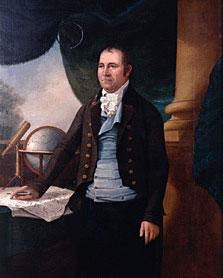
courtesy of www.wikipedia.org
Following the Revolutionary War, Simeon DeWitt, the State Surveyor General and the man who developed Ithaca, included the northern portion of what became Tompkins County in the New Military Tract, land given to veterans in payment for their military service. The southern portion of what became Tompkins County fell into the Watkins and Flint Purchase, a private land development company with headquarters in Owego.
Exploratory visits to the headwaters of Cayuga Lake began in 1786. Settlement followed the 1790 dispersal of Military Tract lots. Some who came were squatters willing to take a chance on the land—and who eventually lost title to it. Others came seeking their military allotments. Some traveled from the east through the dense forest, or came up on rough roads cut into the wilderness by order of the state.
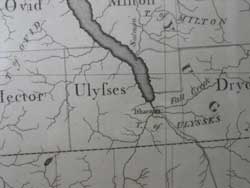
Those taking up land the southern portion of what became Tompkins County—in today’s towns of Danby and Caroline and Newfield--were eastern New Yorkers, such as John Cantine who received state land in payment for services to the state. There were Southerners, too, looking for new land on which to resettle who bought tracts of land in numbered towns, such as Town #11, which became the Town of Caroline. Following the early settlers came ministers, lawyers, and merchants with goods for sale.
Hamlets grew up where an owner was willing to offer land (at Tremans, now Trumansburg) or where there were opportunities for milling (at Ludlow’s, now Ludlowville). For the land at the lake shore, Simeon Dewitt drew up a map of a village expecting it to become a commercial metropolis. His map of 1803 had placed the name Ithaca on the land, as did his 1807 sketch of streets. His land lay within Military Tract #22, the town of Ulysses. Settlement throughout the county followed these initial events. In 1810 DeWitt Clinton wrote that the “village has several houses, three taverns, and two or three stores, and mills in a ravine or hollow.”
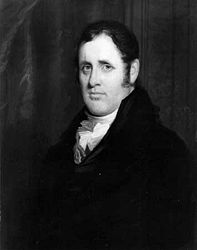
courtesy of Wikipedia.org
Following the Embargo Act of 1808 salt and gypsum from Salina, New York, near Syracuse, went south by way of Cayuga Lake and then through Ithaca, enlivening the local economy. In 1810 the state chartered the Ithaca-Owego Turnpike and Ithaca became a trans-shipment point for goods flowing south. To regulate the teamsters, who sometimes numbered up to 400 at any one time, residents, in the absence of any state or federal authority other than the Postmaster, formed a Moral Society that acted to stem their boisterous antics.
The state of New York created Tompkins County on April 7, 1817 and named the new county for Daniel D. Tompkins, governor of the state (1807-17) and Vice President of the United States (1817-25). Tompkins never saw the county named for him. Tompkins County was initially pieced together from the Military Tract town of Dryden, from lots 51 to 100 of the town of Locke (which became Groton), from lots 42 to 100 of Milton (which became Lansing) all formerly within Cayuga County. To these were added lots 43 to 100 of Ovid, renamed Covert, and all of the towns of Ulysses and Hector, taken from Seneca County. In 1817, the small community fostered by Simeon DeWitt was designated county seat. In 1821 the state designated Ithaca a village within the Town of Ithaca, separated from the Town of Ulysses.
